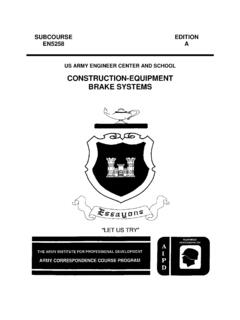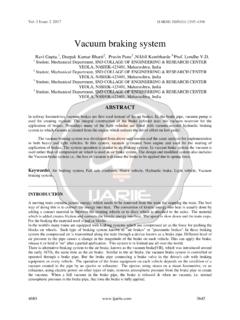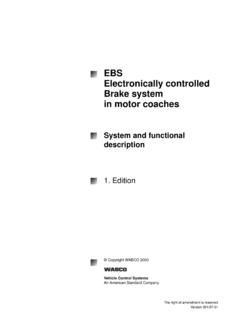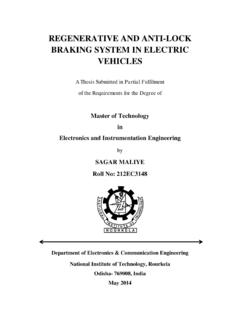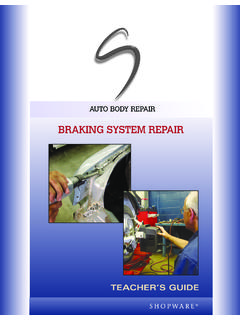Transcription of US ARMY LIGHT WHEEL VEHICLE MECHANIC
1 US army LIGHT WHEEL VEHICLE MECHANIC MOS 63B SKILL LEVEL 3 COURSE WHEELED VEHICLE braking SYSTEMS SUBCOURSE NO. OD1008 US army Ordnance Center and School Five Credit Hours GENERAL The Wheeled VEHICLE braking Systems subcourse, part of the LIGHT WHEEL VEHICLE MECHANIC MOS 63B Skill Level 3 course, is designed to teach the knowledge necessary to develop the skills for servicing and maintaining braking systems. Information is provided on the principles and operation of mechanical, hydraulic, air-hydraulic, air, and electric brake systems. Information is also provided on the inspection of these systems. This subcourse is presented in three lessons, each lesson corresponding to a terminal objective as indicated below. Lesson 1: FUNDAMENTALS OF WHEELED VEHICLE braking SYSTEMS TASK: Describe the principles of automotive brake systems and the construction and operation of mechanical and hydraulic brake systems.
2 CONDITIONS: Given information on the principles of braking , and the construction and operation of internal and external drum brakes, disk brakes, mechanical and hydraulic brake systems, and parking brakes. STANDARDS: Answer 70 percent of the multiple-choice test items covering fundamentals of wheeled VEHICLE braking systems. Lesson 2: AIR-HYDRAULIC BRAKE SYSTEMS TASK: Describe the principles, construction, and operation of air-hydraulic brake systems. CONDITIONS: Given information on the purpose, components, operation, and inspection of air-hydraulic brake systems. STANDARDS: Answer 70 percent of the multiple-choice test items covering fundamentals of air-hydraulic brake systems. i Lesson 3: AIR-BRAKE SYSTEMS TASK: Describe the principles, construction, and operation of straight air-brake systems. CONDITIONS: Given information on the components and operation of straight air-brake systems.
3 STANDARDS: Answer 70 percent of the multiple-choice test items covering fundamentals of air-brake systems. ii TABLE OF CONTENTS Section Page TITLE PAGE .. i TABLE OF CONTENTS .. iii introduction TO WHEELED VEHICLE braking SYSTEMS .. vi Lesson 1: FUNDAMENTALS OF WHEELED VEHICLE braking SYSTEMS Learning Event 1: Describe the Principles of braking and braking Systems .. 1 Learning Event 2: Describe the Construction and Operation of Hydraulic Brake Systems .. 24 Learning Event 3: Describe Inspection Procedures for Hydraulic Brake Systems .. 30 Practice Exercise .. 35 Answers to Practice Exercise .. 36 Lesson 2: AIR-HYDRAULIC BRAKE SYSTEMS Learning Event 1: Describe the Components of the Air-Hydraulic Brake System .. 37 Learning Event 2: Describe the Operation of the Air-Hydraulic Brake System.
4 48 Learning Event 3: Describe Inspection Procedures for the Air-Hydraulic Brake System .. 56 Practice Exercise .. 63 Answers to Practice Exercise .. 64 iii Section Page Lesson 3: AIR-BRAKE SYSTEMS Learning Event 1: Describe the Components of the Straight Air-Brake System .. 65 Learning Event 2: Describe the Operation of the Straight Air-Brake System .. 73 Learning Event 3: Describe Inspection Procedures for the Straight Air-Brake System .. 80 Practice Exercise .. 87 Answers to Practice Exercise .. 88 ** IMPORTANT NOTICE ** THE PASSING SCORE FOR ALL ACCP MATERIAL IS NOW 70%. PLEASE DISREGARD ALL REFERENCES TO THE 75% REQUIREMENT. iv THIS PAGE INTENTIONALLY LEFT BLANK v introduction TO WHEELED VEHICLE braking SYSTEMS Up to this point, each one of our subcourses has covered all the things that were needed to make a VEHICLE go forward and backward.
5 We now know that an operator has controls to make this equipment go fast or slow; to the right or left; through mud, snow, sand; and on level roads. But what does the operator do if a child runs out in front of this moving VEHICLE , or when traveling on a road a point is reached where a bridge is washed out? The answer is that the operator must have one or more controls that will bring the VEHICLE to a stop rapidly and with a small amount of effort. The braking system provides these controls. braking is the use of friction to slow a VEHICLE , bring it to a halt, or hold it in a standing position. A brake is a device that is secured to the VEHICLE axle housings, which do not rotate, and is used to slow down or hold the wheels, which do rotate. When the rotating parts are brought in contact with the nonrotating parts, the friction caused by the rubbing creates the braking action.
6 All vehicles must be built so they meet the minimum braking requirements. For many years it has been a set standard that a braking system must be able to stop a VEHICLE traveling 20 miles per hour (MPH) within 30 feet. You must remember, however, this does not mean the VEHICLE will always stop in 30 feet. It does mean that if the tires could get enough traction on the road, the brakes must hold well enough to stop it in that distance. To get an idea of how much power is involved in braking systems, imagine a 10,000-pound truck traveling 50 MPH being braked at the rate discussed above. The energy required to do the braking would be equivalent to 500 horsepower (HP). This is much more than the VEHICLE engine could ever produce. Most of the braking systems on modern passenger cars can handle about eight times the power developed by the engine. This subcourse is designed to provide you with a knowledge of how braking system components operate.
7 Vi Lesson 1/Learning Event 1 LESSON 1 FUNDAMENTALS OF WHEELED VEHICLE braking SYSTEMS TASK Describe the principles of automotive brake systems and the construction and operation of mechanical and hydraulic brake systems. CONDITIONS Given information on the principles of braking and the construction and operation of internal and external drum brakes, disk brakes, mechanical and hydraulic brake systems, and parking brakes. STANDARDS Answer 70 percent of the multiple-choice test items covering fundamentals of wheeled VEHICLE braking systems. REFERENCES TM 9-8000 Learning Event 1: DESCRIBE THE PRINCIPLES OF braking AND braking SYSTEMS introduction braking action on wheeled vehicles is the use of a controlled force to hold, stop, or reduce the speed of a VEHICLE . Many factors must be considered when designing the braking system for an automotive item. The VEHICLE weight, size of tires, and type of suspension are but a few that influence the design of a system.
8 1 Lesson 1/Learning Event 1 The power needed to brake a VEHICLE is equal to that needed to make it go. However, for safety reasons, brakes must be able to stop the car in a very short distance. As an example, a passenger car equipped with an 80-HP engine can normally accelerate from a standstill to 60 MPH in about 36 seconds. On the other hand, the brakes must be able to decelerate the VEHICLE from 60 MPH to a stop in 4 1/2 seconds. You can therefore see the braking force is about eight times greater than the power developed by the engine. Each part in the braking system must operate with a very positive action to accomplish this tremendous braking effort. The job of a wheeled VEHICLE MECHANIC is to maintain the braking components in a state of repair that ensures serviceable brakes when needed. For you to keep brake system components in a working shape, you must understand how the system works.
9 In this lesson, we will discuss the principles of operation for components contained in various types of braking systems. braking action is the use of a controlled force to slow the speed of or stop a moving object, in this case a VEHICLE . It is necessary to know what friction is to understand braking action. Friction is the resistance to movement between two surfaces or objects that are touching each other. An example of friction is the force which tries to stop your hand as you apply pressure and slide it across a table or desk. This means that by forcing the surface of an object that is not moving (stationary) against a moving object's surface, the resistance to movement or the rubbing action between the two surfaces of the objects will slow down the moving surface. Automotive vehicles are braked in this manner. 2 Lesson l/Learning Event 1 PRINCIPLES OF braking FIGURE 1. DEVELOPMENT OF FRICTION AND HEAT.
10 Brakes on early motor vehicles were nothing more than modified wagon brakes used on horse-drawn wagons. These were a hand-operated, mechanical, lever-type brakes that forced a piece of wood against one or more of the wheels. This caused friction or a drag on the WHEEL or wheels. There is also friction between the WHEEL and ground that tries to prevent the WHEEL from sliding or skidding on the ground. When a VEHICLE is moving, there is a third force present. This force is known as kinetic energy. This is the name given the force that tries to keep any object in motion once it has started moving. 3 Lesson 1/Learning Event 1 When the brakes are applied, the WHEEL will either roll or skid, depending on which is greater, the friction between the braking surfaces or between the WHEEL and the road. Maximum retardation (slowing down) is reached when friction between the brake surfaces is just enough to almost lock the WHEEL .
